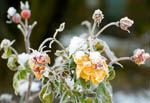Winter gardening in all weathers
You can make the most of your time no matter what the weather this winter, as Tom Coward demonstrates


Gardening is a constant race with Nature, but deep winter, when the garden is sleeping, is one of the few times we hold the advantage. All the work we do now will help give us a head start in spring. Although the weather can often be unpleasant in January, some forward planning can ensure we make the most of this valuable season in the garden.
In good weather
When the weather is good and the ground isn't waterlogged or frozen, we always seize the moment to work on the soil, whether it be regenerating a border or digging the kitchen garden. The soil is, undoubtedly, the single most valuable resource in the garden, and must always be treated with the utmost care and respect. Working with wet soil is a miserable, muddy task and will ruin its structure, causing long-term problems for years. If we ever have to walk on the soil when wet, we always put down old scaffold planks first, to help prevent any compaction, but, if possible, we stay off the ground until conditions are perfect.
Our kitchen garden covers about 10 acres and the heart of it is divided into six beds, which rotate annually, most of the cultivation work being carried out by a rotovator. This brilliant machine saves hours of labour, but it will only till the soil to quite a shallow depth and continual use of it can cause damage to the soil by smearing and panning at that cultivation depth. So, each year, two of the beds are trench-dug to a deeper level as part of the rotation, with well-rotted horse manure added for fertility.
When the weather has been dry enough and the sun is shining on a crisp winter's day, there is nothing like the joy of digging dark, rich compost into the kitchen-garden soil and the exercise in January is usually a good thing for the garden team, as we do all like to overindulge a little over Christmas. When it rains Gardeners are hardy creatures, who get a strange pleasure from working outside in extreme weather, but cleaning tools, servicing machinery, organizing the potting shed and ordering seeds are all essential tasks and they can be done inside when the weather is wet.
One of the most important rainy-day jobs is cleaning the glass of the cold frames and greenhouses. Algae builds up on the glass over the year and restricts the light that can reach the plants beneath. A light pressure wash, followed by a clean brush and a bucket of detergent, always does a good job on the outside of the greenhouse. In the interior, care must be taken not to get the over-wintering plants wet, so a more gentle wipedown with a cloth is preferred.
* Country Life New Year subscriptions sale
Sign up for the Country Life Newsletter
Exquisite houses, the beauty of Nature, and how to get the most from your life, straight to your inbox.
In frost or snow I tend to save pruning for periods of snow or long freezes, and the biggest job of this kind we have is our two-acre apple orchard. This can be tough work when it's cold, but, if we're lucky enough to have some mild weather, it's a job best enjoyed with some late-winter sunshine on your back.
There is a brilliant description of apple-pruning techniques in the RHS Encyclopedia of Gardening. Most of our apples are spur-fruiting varieties and we grow them as large, open centred, vase-shaped trees, which look best in broken rows growing in a bulb-rich wildflower meadow. Most of the work is simply a case of reducing the annual growth back to the fruiting spur and removing any old branches that are in the way of suitable replacements. The end result should be a freefruiting tree, which casts only dappled shade at high summer, ensuring plenty of sunlight will reach the developing fruit to sweeten their flavour.
With a little luck, by next autumn, our work should be rewarded with a crop of good apples so that we can make our own juice to serve in the hotel.
Tom Coward is Head Gardener at Gravetye Manor
* Follow Country Life magazine on Twitter
Country Life is unlike any other magazine: the only glossy weekly on the newsstand and the only magazine that has been guest-edited by HRH The King not once, but twice. It is a celebration of modern rural life and all its diverse joys and pleasures — that was first published in Queen Victoria's Diamond Jubilee year. Our eclectic mixture of witty and informative content — from the most up-to-date property news and commentary and a coveted glimpse inside some of the UK's best houses and gardens, to gardening, the arts and interior design, written by experts in their field — still cannot be found in print or online, anywhere else.
-
 A villa from paradise on Koh Samui where the pool might be bigger than the house
A villa from paradise on Koh Samui where the pool might be bigger than the houseSituated on the Samujana Estate, a filming location for the White Lotus, Villa 24 has got it all
-
 ‘Greece — it’s eternal and makes me feel ancient and youthful at the same time’: Isabel Ettedgui’s Consuming Passions
‘Greece — it’s eternal and makes me feel ancient and youthful at the same time’: Isabel Ettedgui’s Consuming PassionsThe owner of Connolly reveals what she would take to a desert island and why she once waited four years to get a supper reservation.